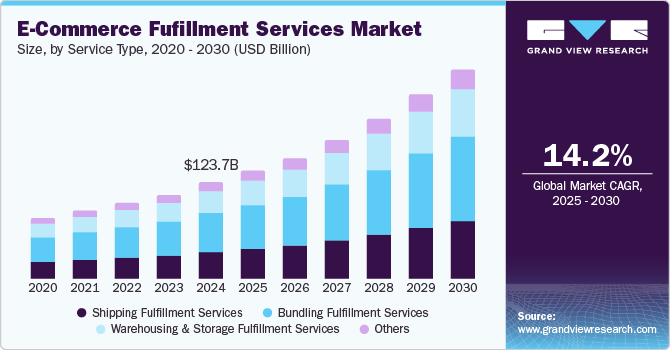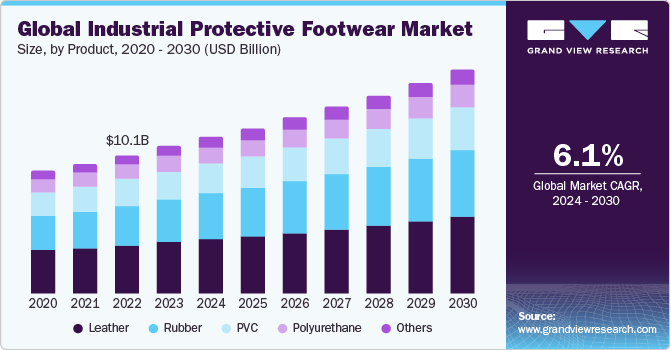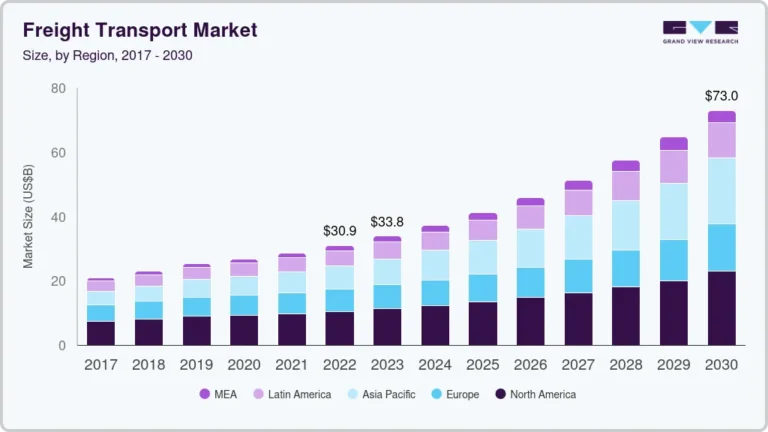E-commerce Fulfillment Services Market Size, Share & Trends Analysis growing at a CAGR of 14.2% from 2025 to 2030

The global e-commerce fulfillment services market size was estimated at USD 123.68 billion in 2024 and is projected to reach USD 272.14 billion by 2030, growing at a CAGR of 14.2% from 2025 to 2030. The proliferation of electronic commerce and the resulting rise in the number of online buyers, especially in emerging economies, is anticipated to fuel the growth of the industry.
Key Market Trends & Insights
- The e-commerce fulfillment services market in Asia Pacific dominated the global industry and accounted for more than 27% of the global revenue share in 2024.
- China’s e-commerce fulfillment services market commands a significant position within the Asia-Pacific region.
- By type, the e-commerce shipping fulfillment service segment led the market and accounted for more than 39.9% of the global revenue in 2024.
- By sales channel, the business-to-business segment dominated the overall market and accounted for a share of more than 60% of the global revenue in 2024.
- By application, the consumer electronics segment is expected to emerge as the fastest-growing segment, registering a CAGR of 16.5% from 2025 to 2030.
Market Size & Forecast
- 2024 Market Size: USD 123.68 Billion
- 2030 Projected Market Size: USD 272.14 Billion
- CAGR (2025-2030): 14.2%
- Asia Pacific: Largest market in 2024
Request a free sample copy or view report summary: https://www.grandviewresearch.com/industry-analysis/ecommerce-fulfillment-service-market/request/rs1
Fulfillment service centers enable online merchants to outsource services, including bundling, warehousing, shipping, and other value-added services such as return management and urgent parcel service. A fulfillment center is ideal for merchants who do not have robust warehousing capabilities to manage inventory directly and do not want to invest additional efforts in shipping. Besides, e-commerce fulfillment services can be managed in-house by the online merchant too.
Several consumers prefer ordering products online over in-store shopping due to several benefits offered in terms of convenience, cost, variety of choices, and lead time. E-commerce businesses significantly depend upon warehousing and shipping capabilities to get products transported from manufacturing units/ retailers to end-users in a shorter lead time. Traditionally warehousing was highly labor-intensive; however, in recent years, merchants have begun automating operations within the aisles of modern warehouses to minimize human intervention and thereby improve fulfillment productivity and reduce order delivery time. For instance, Amazon.com, Inc. uses robots in its fulfillment centers to assist associates in performing operations and drive faster shipping times.
With the majority of online purchasing sales coming from the urban area, and consumers increasingly demanding product delivery in the shortest possible turnaround time, the location of a fulfillment center is of strategic importance to e-commerce companies. Having centers near major cities that not only house products, but also perform other fulfillment services like sorting, bundling, labeling, and shipping helps players in the electronic commerce market to deliver products in a shorter turnaround time and win customer’s confidence. Thus, fulfillment centers remain a preferred choice for e-commerce companies that require efficient partners for their fulfillment operations.
COVID-19 Impact
The COVID-19 pandemic has severely impacted the world economy, leading to unprecedented wealth destruction of businesses and individuals. Governments worldwide took/are taking varied measures to contain the spread of the infection, such as mandatory lockdowns and restrictions on movement and transportation activities, and border restrictions. These restrictions have taken a severe toll on businesses across every sector, curbing profits and drying up cash flows and financial reserves.
E-commerce companies and fulfillment centers are no exception to this, as the industry suffered a minor setback during the initial phases of the pandemic due to supply chain disruptions and labor shortages. The relaxation of norms to permit the resumption of logistics and transportation services for essential products during lockdowns helped increase the demand for e-commerce fulfillment services. Increased preference for e-commerce services, which helped reduce the rate of spreading infection by providing online delivery of products and services, worked in favor of the e-commerce fulfillment services market in 2020 and continues to drive the market. In addition to e-commerce companies, supermarkets also started delivering online door-to-door services to their consumers, helping prevent the risk of infection from in-store visits. This has further given a boost to online payments and reduced in-person cash transactions.






